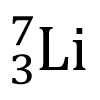Radioactive Decay Flashcards
(50 cards)
What is the atomic number of the nucleus shown below?

3 (this lower number is also known as the ‘proton number’)
What is the mass number of the nucleus shown below?

7 (this upper number is also known as the ‘nucleon number’)
What is the nucleon number of the atom shown below?

7 (this upper number is also known as the ‘mass number’)
What is the proton number of the atom shown below?

3 (this lower number is also known as the ‘atomic number’)
How many protons does the nucleus shown below have?

3
How many neutrons does the nucleus shown below have?

4 (it’s the difference between the mass number and the proton number)
Lithium-6 and Lithium-7 are isotopes. What does the word ‘isotopes’ mean here?
It means they have the same number of protons but different numbers of neutrons
What is the mass number of Lithium-7?
7
Sometimes a large, unstable nucleus will change into a new element, emitting an energetic particle as it does so. What is the name for this process?
Radioactive decay
During alpha decay, an unstable nucleus emits an alpha particle. What is an alpha particle?
A highly energetic particle made of two protons and two neutrons
During beta decay, an unstable nucleus emits an alpha particle. What is a beta particle?
A very high energy electron
What is a gamma ray?
A very high frequency electromagnetic wave
We refer to alpha particles, beta particles and gamma rays as ‘ionising radiation’. What does this mean?
They can knock electrons off atoms (when they collide with them)
Which kind of ionising radiation can be stopped by a sheet of card?
Alpha particles
Which kind of ionising radiation can be stopped by a few cm of air?
Alpha particles
Which kind of ionising radiation will pass through card, but can by stopped by a few mm of aluminium?
Beta particles
Which kind of ionising radiation will pass through a few mm of aluminium, but will be stopped by a few metres of lead?
Gamma rays
Name two things you could use to detect ionising radiation.
A Geiger counter
Photographic film
Name two health risks posed by exposure to ionising radiation.
Cell damage Genetic mutation (including a risk of cancer)
What is the name for the energetic particle made up of two protons and two neutrons, sometimes released when an unstable nucleus decays?
An alpha particle
What is the name for a highly energetic electron, sometimes released when an unstable nucleus decays?
A beta particle
What is the name of the high frequency e-m wave emitted when an unstable nucleus decays?
A gamma ray
What is the mass number of an alpha particle?
4
What is the proton number of an alpha particle?
2








